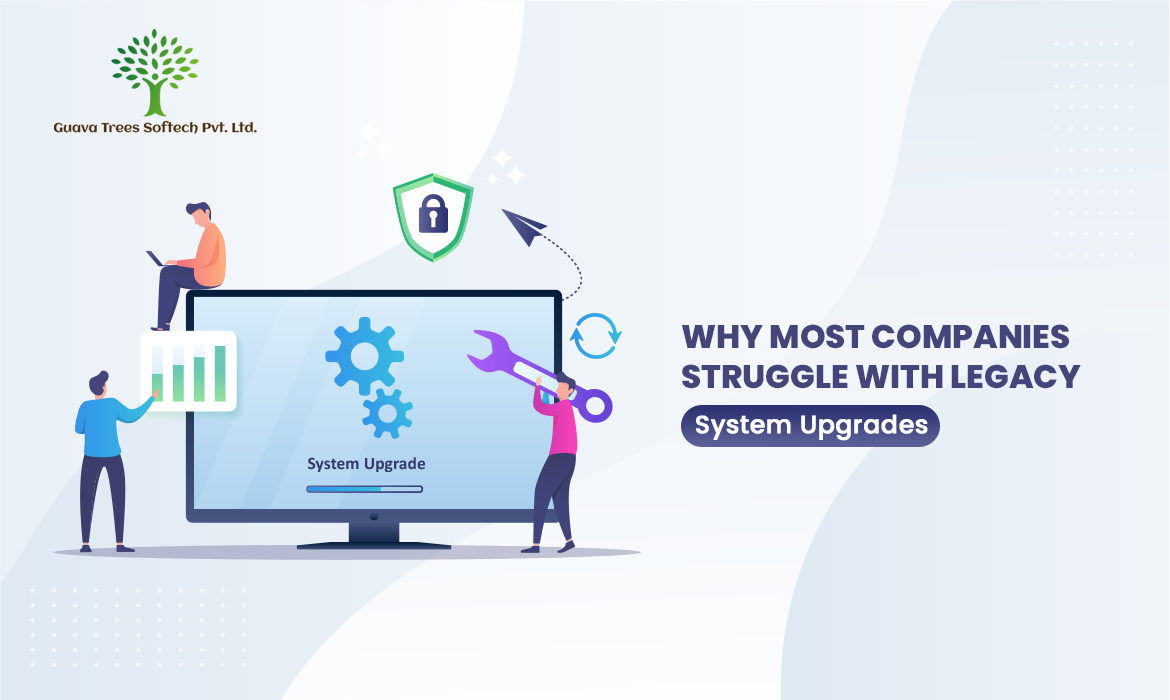In a technology-driven world, the backbone of many organizations still relies on legacy systems which are outdated, monolithic software that continues to power mission-critical operations. While these systems were once cutting-edge, today they pose significant challenges in a world that demands speed, scalability, security, and seamless integrations.
At Guava Trees Softech Pvt. Ltd, we’ve worked with enterprises across sectors, helping them modernize their technology landscapes. One question we hear constantly is: Why is upgrading legacy systems so difficult? The answer is complex, involving technical, organizational, and cultural factors. Let’s dive deeper into the reasons most companies struggle with legacy system upgrades, and what can be done about it.
- Complexity And Interdependencies
Legacy systems are often built on decades-old technologies with deeply intertwined modules and hard-coded logic. Over the years, layers of patches, quick fixes, and customizations accumulate, resulting in what is sometimes called spaghetti code.
When companies attempt to upgrade or replace these systems, they realize that each module is heavily dependent on others, and even a minor change can trigger cascading failures. This complexity makes it incredibly hard to refactor, test, and deploy upgrades safely.
Technical Debt further amplifies this challenge. Without continuous modernization, companies end up maintaining systems that no one fully understands, with documentation either incomplete or outdated.
- Lack Of Skilled Resources
Another critical roadblock is the shortage of professionals with expertise in legacy technologies like COBOL, RPG, or mainframe assembly language. As senior staff retire, organizations lose institutional knowledge that is nearly impossible to replace.
Newer developers, trained on JavaScript, Python, or cloud-native frameworks, often have neither the experience nor the interest to work with legacy stacks. As a result, companies face a widening skills gap that makes upgrades even more challenging.
- Fear Of Disruption To Business Operations
For many companies, legacy systems are the lifeblood of day-to-day operations managing financial transactions, supply chains, customer data, and more. Upgrading these systems introduces the risk of downtime, data loss, or even catastrophic failures.
The fear of disrupting mission-critical processes discourages organizations from attempting bold modernization moves. Instead, they continue applying patches to “keep the lights on,” postponing fundamental changes year after year.
- High Costs Of Modernization
Legacy system upgrades are not cheap. They often require specialized resources, significant testing, and meticulous data migration plans. Moreover, legacy systems frequently integrate with multiple external vendors and third-party services, which further raises costs and complicates the upgrade path.
Even when companies allocate budgets for modernization, these budgets often get redirected due to more urgent short-term needs. As a result, legacy upgrades remain underfunded and deprioritized.
- Regulatory And Compliance Challenges
Industries like banking, healthcare, and insurance are tightly regulated. Any changes to the underlying systems must comply with strict industry standards and security protocols.
Migrating a legacy system to modern architecture typically involves data handling, encryption updates, and validation processes that must pass regulatory audits. Failing to meet these requirements can result in legal and financial consequences. This regulatory burden often slows down modernization efforts.
- Data Migration Complexities
Legacy systems tend to store data in outdated formats and database structures that are not compatible with modern relational or cloud-based databases. Migrating this data while maintaining its integrity, relationships, and security is one of the most technically challenging parts of a legacy upgrade.
Moreover, data volumes may have grown exponentially over the years, making the migration a high-stakes exercise. Data cleansing, deduplication, and transformation are time-intensive, error-prone tasks if not managed with robust ETL (Extract, Transform, Load) pipelines and meticulous governance.
- Cultural Resistance to Change
Even if a company is technically prepared for modernization, change management is often its own battlefield. Employees accustomed to legacy systems may resist moving to newer platforms out of fear, lack of training, or job security concerns.
Leadership teams, meanwhile, may be hesitant to disrupt familiar processes, especially if the ROI of a modernization initiative is unclear in the short term. Overcoming this resistance requires strong stakeholder buy-in, effective communication, and a clear roadmap for user adoption.
- Integration With External Systems
Modern businesses rely on a web of interconnected systems — from vendor portals to customer-facing apps to third-party data feeds. Legacy systems are often built with outdated protocols or rigid architectures that cannot easily connect with modern APIs and microservices.
During an upgrade, these integrations must be carefully re-engineered to avoid breaking dependent systems. This is both a technical and logistical challenge, adding further layers of complexity to any modernization effort.
How Can Companies Overcome These Challenges?
At Guava Trees Softech Pvt. Ltd, we believe that while legacy upgrades are complex, they are not impossible. Here are some strategies that we recommend to our clients:
- Conduct a detailed legacy assessment:Map out the architecture, dependencies, data flows, and risks before making any modernization decisions.
- Adopt a phased approach:Instead of a big-bang replacement, modernize in manageable increments. Prioritize critical modules for early upgrades.
- Leverage modern tools: Automated code analysis, containerization, and cloud migration frameworks can reduce costs and errors.
- Build a knowledge bridge:Pair legacy experts with modern developers to transfer knowledge and build continuity.
- Prioritize stakeholder buy-in:Align leadership, technical teams, and business users with a shared modernization vision.
- Focus on testing:Use automated testing frameworks to ensure quality and stability during upgrades.
- Invest in training:Empower your workforce to adapt to the new systems through structured skill development programs.
Final Thoughts
Legacy systems are not going away overnight. However, as market pressures accelerate and customer expectations rise, the inability to modernize can quickly turn into a business liability.
At Guava Trees Softech Pvt. Ltd, we have helped numerous organizations successfully navigate the challenges of legacy system upgrades. Our deep expertise, proven methodologies, and collaborative approach can help transform your legacy systems into agile, secure, future-ready technology platforms.
Ready to start your modernization journey? Get in touch with Guava Trees Softech Pvt. Ltd today to discuss how we can help you break free from legacy limitations and embrace the future with confidence.







